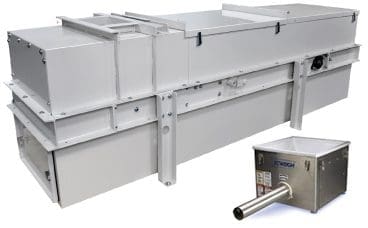Weigh Belt Feeders
Volumetric and Gravimetric Weigh Belt Feeders. LIW Screw Feeders deliver, dose and batch accurately in various bulk handling processes, from food production, agriculture, mining, building products to pharmaceutical flexible hopper applications.
Bulk handling and manufacturing are precision-oriented processes. For example, wheat farmers need to know how much grain they’ve harvested and plasterboard producers must measure exactly how much gypsum they’re using.Also known as weigh conveyors, belt feeders or weigh belt feeders deliver this accuracy. Yet, not every business distributes the same commodities. Whereas a paper mill handles pulp of equal density, a coal mine may handle product of different density and mass. Disparities such as these require solutions tailored to the specific process and have prompted SRO to design and install custom weigh belt feeder solutions for clients in multiple industries.

FEEDERS AS A SOLUTION
Whether an operation involves loading, blending, mixing or batching,SRO Technology can offer a weigh belt feeder which ensures hoppers are distributing the correct amount of material in a given process. In a way, belt feeders are like quality assurance solutions: They guarantee manufactured products will turn out the way they’re supposed to, because they measure exactly how much material facilities are using to create finished commodities. Here are six ways weigh belt feeders support industrial processes:
- Cement and tile factories use them to control the clinker-sand ratio within operations.
- Recycling plants depend on their monitoring capabilities to enhance efficiencies.
- Plasterboard makers use the solutions to accurately measure the throughput of gypsum, vermiculite, fly ash and BMA.
- Food processors rely on feeders to blend the appropriate number of ingredients when making cereals and dog food.
- Farmers use feeders to control and batch grain into trucks.
- Plastics developers use them to control the amount of pellets during the manufacturing process
CUSTOMISING FOR DIFFERENT USES
Due to the versatility of weigh conveyor applications, SRO Technology does not produce one-size-fits-all feeder solutions. Instead, our experts analyse your processes, identify needs and create feeders that satisfy those requirements.Regardless of your business, our solutions are built to withstand the harshest environments, minimising long term equipment maintenance and servicing over the long term. Design features enable our staff to quickly change belts, clean out the interior and conduct other necessary upkeep.If you’d like a consultation, don’t hesitate to speak with one of our experts. With over 50 years of combined experience, our teams know what operations managers in a number of industries look for in these essential solutions.
THE BENEFITS OF WEIGH BELT FEEDERS
Types of feeders:
Volumetric weigh conveyors allow a certain volume of material to pass onto a conveyor within a specific timeframe. These solutions are ideal when a product’s density is consistent, and are very effective at dealing with materials such as grain and gypsum.
Gravimetricweigh conveyors calculate the weight of products passing from hoppers. These systems are preferable when high accuracy is required or variable density is evident. In fact, gravimetric solutions are ideal for detecting changes in product mass.
Customising for different uses
Due to the versatility of weigh conveyor applications, SRO Technology does not offer one-size-fits-all feeder solutions. Instead, our experts analyse your processes, identify needs and create feeders that satisfy those requirements. Regardless of your business, our systems are built to withstand the harshest environments, minimising long-term equipment maintenance and servicing over the long term. Design features enable our staff to quickly change belts, clean out the interior and conduct other necessary upkeep. If you’d like a consultation, don’t hesitate to speak with one of our experts. With over 50 years of combined experience, our teams know what operations managers in a number of industries look for in these essential solutions Just as there are two methods of measurement, there are several types of feeders professionals can choose from. Some belt feeders are well-suited to hoppers, while others are better for augers. Again, the feeder style depends on the required accuracy level, the operations and the kind of products in transit. Using auger conveyors as an example, these systems are responsible for churning liquids, slurry or solid materials. An auger may mix substances to create dog food, plasterboards and so forth. Volumetric feeders funnel material into auger shafts based on the amount of product-specific systems are handling. One thing to note about volumetric weigh feeders is that their range of accuracy is usually between 5-10 per cent of the actual amount of product. So, when accuracy is preferred, gravimetric weigh belt feeders are generally better, as they use load cells and speed-sensing devices.

